

The origin and emplacement of the Cornubian Batholith has been a major focus of research in SW England during the last 150 years. Theories of magma ascent and emplacement have had a profound effect on how the structures (and their origins) at surface, within the granite and surrounding killas, are viewed.
During most of the 20th century, the debate regarding the emplacement of granite batholiths was dominated by the theory of diapirism (Wegmann, 1930; Daly, 1933; Cloos, 1941; Rast, 1970; Read and Watson, 1974; Holmes, 1978; Pitcher, 1979). In this model large bodies of molten magma ascend through the cover rocks by 'shouldering aside' the material in their path, rising by density contrast, volumetric expansion, gas coring, or tectonic squeezing (Rast, 1970). Diapirs penetrate through the plastic (and therefore sufficiently hot) lower and middle crust (the source region is viewed as a regionally extensive, partly ductile layer, with periodic cuspate instabilities and diapiric upwellings) and are brought to a halt when the density contrast is removed or when crystallisation effectively freezes the rock and halts its progress. Continued ascent in the brittle regime of the upper crust is accompanied by piecemeal stoping of the country rocks and assimilation of the xenoliths produced. This type of intrusion can be mathematically modelled; it has an analogy in the formation of salt domes (see Figure 1).
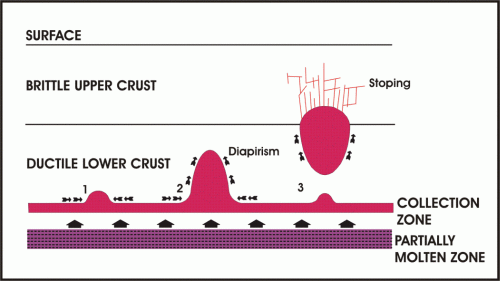
Figure 1. The rise of a diapiric body within the crust. Movement is achieved by a combination of shouldering aside the country rock within the ductile zone, and stoping in the brittle zone (after Bromley and Holl, 1986).
. LOFT Braided Cotton Stretch Belt
LOFT Braided Cotton Stretch Belt
We love how effortlessly a natural cotton style matches back to just about everything. Buckle closur..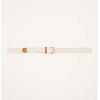 Offer Price : USD 29.50Manufacturer : Cotton Belt
Offer Price : USD 29.50Manufacturer : Cotton Belt
A number of workers (Clemens, 1998; Clemens et al, 1997; Hutton, 1988) have taken a critical look at the existing diapiric model, using a combination of mathematics, fluid mechanics and geological field evidence. In this model (the ascent of an isothermal, buoyant, spherical diapir) the viscosity of the cover rocks is critical. High values for unmelted crustal rocks (1024 Pa s), and the loss of thermal energy from the diapir to its surroundings is likely to result in very slow rates of ascent (e.g 10 –8 to 10 –10 m s –1). The diapir will also have to expend increasing amounts of energy, as it rises, to heat up the cover rocks enough to allow it to plastically deform them and continue its upward progress (Clemens, 1998). Modelling of this aspect of diapiric ascent suggests that as heat loss, viscosity (both in the granite and the wall rocks) and crystallisation increase as the diapir moves upwards, these factors would effectively ‘ freeze’ a diapir of any given size at depths of at least 14 km below the surface. Altering the parameters to take into account non-uniform rheologies and temperature-dependent viscosities does not significantly change the results (allowing a diapir to rise a maximum of 15 km in 10,000 years). Such a time scale allows for considerable conductive cooling and crystallisation. This would effectively rule out the development of shallow level, large plutons by this method.
The corresponding field evidence for diapiric ascent is also lacking in the geological record. The deformation around a diapir ascending by hot-Stokes flow would extend for many body widths beyond the pluton. This is not seen in the field. Diapir tracks (pipe-like, high-grade shear zones in which the cores have moved up) apparently do not exist. Sophisticated structural tests have been applied to postulated granitic diapirs, which they have universally failed to pass (Clemens, 1998), though some workers (Miller and Paterson, 1999; Dietl, 1999) advocate visco-elastic diapirism as a valid method of emplacement. Granitic bodies in the upper crust commonly have forms and structures indicating that diapirism cannot have been the emplacement mechanism (Brown and Tryggvason, 2001), irrespective of how ascent may have occurred. Diapiric ascent should give rise mainly to diapiric emplacement, since the magma would have little or no potential to migrate further once the diapiric process had finished.
Modern theories of granite emplacement have centred on dyke-fed transfer of magma (Cruden, 1998; Baker, 1998; Petford et al., 2000) to higher levels in the crust and the creation of space to form large intrusions.
Granitic magmas can be formed by the fractionation of a mafic parent (tholeiites and hydrated ocean floor rocks in ophiolite complexes), but the vast majority of granites have a crustal origin (Chappell and White, 1974; Pitcher, 1979). The partial melting of common crustal rock types such as metapelites, metagreywackes, meta-andesites and some amphibolites, under upper amphibolite - granulite facies conditions, can yield up to 50 vol% of water undersaturated granitic melt (Clemens, 1998) under the right conditions.
Granitic melts (minimum melting point fraction) form at
~850°C. Temperatures at the base of the (old) crust are often below this
(often around 500°C at a 35 km MOHO in stable continental crust, a
geothermal gradient of 15°C km-1
Other contributory factors to melt production are the fertility of the source region (how close the source rocks are chemically to granite eutectic/minimum composition), the amount and availability of H2O, the ambient temperature and the location, intensity and duration of the heat supply. Metapelites are amongst the most fertile source rocks and can supply up to 60% melt under the most extreme conditions (Thompson, 1999). Experimental data has shown that melts produced under amphibolite facies conditions are only poorly mobile and that the most voluminous and mobile melts are produced under granulite facies conditions at temperatures in excess of 850°C. Such melts are regarded as the primary material components of large-volume granitic magmas in a variety of tectonic environments. This is because the solidi of melts produced by this mechanism have positive dPldT slopes and the magmas can rise (decompress) to high levels in Earth's crust before crystallisation. Such melts have the potential to form large-volume, restite-poor plutons or silicic volcanic complexes. The positive volumetric changes that take place during these granulite facies dehydration melting reactions also contribute to magma transport and segregation by causing localised fracturing and loss of rock strength around the source region due to increased pore fluid pressures (Thompson, 1999; Petford et al., 2000).
It has been postulated that granitic magmas may move through the crust in a 'pervasive' manner, rather than by focused flow in either diapirs or dykes (This idea has been put forward mainly by those working in migmatite terranes; Weinberg and Searle, 1998), commonly associated with major shear zones. The process is one in which melt migration is controlled by both its buoyancy and by tectonism. Melt is concentrated into low-pressure zones created during deformation, and mostly forms stromatic complexes in which the melt is trapped in a distributary system of veins and, often horizontal segregations (Vigneresse, 1999). These processes are seen as occurring slowly, and the percolative flow is inefficient in expelling the melt. If such melt veins build up to a sufficiently high volume proportion, the entire rock mass could be said to form a sheeted or foliated granitic pluton.
Petford and Koenders (1998a), modelling magma generation, suggested that in rapidly heated continental crust the positive volumetric strain (~1.5% with DVmelting positive) associated with melting could overcome the elastic limit of the country rock and generate fractures, well within the ductile zone, providing that the thermal 'shock' is great enough. In areas where underplating by mantle-derived magmas is taking place, the geothermal and rheological gradients can be very high and the generation of an interstitial melt fraction will reduce rock strength even further. The development of this fracture system (with spacing ranging from 10-10 to 10-5 m2) is prograde and in the model, leads to a self-organised, highly connected, vertical directional system on a time scale of 105 years. The development of this network would allow magma generated over a wide area to collect and form larger feeder channels at areas of higher connectivity. The threshold of liquid percolation (Vigneresse, 1999) is in the region of 8 - 25% melt, for flow to occur. This process of magma migration out of the lower crust not only leaves this area (the protolith) in a depleted restite state, but enriches the upper crust with LIL and radiogenic elements. This has been cited as the major process responsible for crustal differentiation. The development of feeder pathways may also tap into the underlying basic magmas and some preserved feeder dykes and plutons preserve evidence of magma mixing/immiscibility from the two source areas, leading to the development of hybrid magmas (Menendez and Ortega, 1999).
Anatectic processes operate at deep crustal levels (20 - 40 km) and yet many granite batholiths and their associated volcanics occur at shallow crustal levels (0 - 10 km), with the majority of batholiths rooted at an average of 7 ± 2 km (Vigneresse and Cuney, 1991). Many of these granitic magmas have, therefore, travelled 10 - 40 km through the crust during their ascent, prior to emplacement. With the possible exception of diapirism and the generally small volumes of magma frozen in dykes, there is no reason to suppose that ascent and emplacement must occur either by the same mechanism or at the same volumetric rate (Cruden, 1998).
Dykes as potential feeders to larger plutons were recognised in areas such as the Rockies earlier this century (Clemens, 1998) and, later, in the Himalayas. Geophysical surveys in the Massif Central have found non-diapiric smaller plutons, fed by stalk-like structures. Dykes can occur at all structural levels on scales from the millimetric to hundreds of metres, demonstrating the ability of magma to penetrate rocks by fracture propagation (Hutton, 1992).
Dyke models imply that all magmas, once separated from their source region, behave in the same way mechanically (any differences will reflect viscosity, etc). In dyke intrusion the limiting factor is not wall rock viscosity, but magma viscosity (Clemens and Petford, 1999; Vigneresse, 1999; Baker, 1998; Dingwell, 1999). The major factors that control this (outside of composition, which for this granitic model will be assumed to be uniform) are magma temperature (typically 850 - 950°C) and melt H2O content (typically 2 - 4%), which may be influenced by the presence of halogens, boron and other volatiles. The addition of 2% water to an anhydrous granitic melt at 800°C reduces viscosity by six orders of magnitude, equivalent to raising the temperature by 500°C (Baker, 1998).
Modelling of these parameters shows that granitic magmas have viscosities in the range 104 - 106 Pa s; also that this viscosity varies only slightly under crustal pressure values and even with 30 vol% crystals in the melt, it only suffers a small increase. In these experiments crystal distribution was found to be more important than content, which agrees with the work of Petford and Koenders (1998b), who described the flow in dykes in terms of the Bagnold Effect (as seen in solid/liquid transport in pipes). In magmatic granular flow, crystals (i.e. phenocrysts) become concentrated in the centre of flow at the pipe axis, while the margins are largely solid-free. This change in solidosity results in a low viscosity margin and higher viscosity core (and also explains the concentration of phenocrysts seen in dykes, away from the margins). This leads to a lubrication effect, which in turn allows dyke transport to continue even with significant solid content.
By the time the solid content reaches 40 vol% the magma will become so viscous that it will essentially behave as a crystal mush or an anelastic solid with a non-zero shear modulus. The rheology will be strain-rate dependent and the magma will continue to move only if deformed (Bagdassarov and Dorfman, 1998).
By using the crystal-free estimates of viscosity, modelling suggests rates of ascent from 3 x 10-3 to 1 m s-1 for dykes between 3 and 13 m thick (typically 0.1 m s-1). This is 10,000 to 100 million times faster than that for any modelled diapir. The dykes are self-propagating and will continue to extend as long as they contain buoyant magma within the calculated viscosity range and (critical) width range (Clemens and Petford, 1999). As long as the dyke is within these parameters it will continue to act as a magma pathway, advecting heat faster than losing it by conduction through the fracture walls. In this way a dyke 1 km long and 3 m wide could supply a growing pluton with 1000 km3 of magma in around 1200 years - it would take 25 times as long to solidify (Petford and Koenders, 1998b). It is, therefore, possible to transfer large volumes of granitic magma by this process in very short time frames. The volume of magma transferred will not be limited by the rate of ascent, but by rates of melt segregation in the source region and how rapidly the magma can be accommodated at its emplacement site (related to the rate of deformation of the host rocks). Under these conditions of very high strain rates and rapid transfer of magma to the emplacement site, pluton growth could easily outstrip the rate of conductive heating of the wallrocks, leading to the possibility that the pluton could be fully emplaced before significant contact metamorphism of the wallrocks initiated (Johnson et al., 2001).
tabular
geometries in a large number of granitic plutons (Vigneresse, 1990; Ameglio and
Vigneresse, 1999). A good example of how extrapolation of map-based (2D)
interpretations of intrusion shape with depth can lead to misinterpretations of
actual intrusion geometry comes from a recent high-resolution seismic
reflection survey beneath the Lake District batholith. Here, plutons previously
modelled using gravity data as outwardly expanding 'diapiric' structures are
instead interpreted to be a stacked series of  Mizani True Textures Curl Replenish Intense Moisturizing Mask - 8 oz
Mizani True Textures Curl Replenish Intense Moisturizing Mask - 8 oz
Mizani True Textures Curl Replenish Intense Moisturizing Mask This ultra-rich, deep penetrating tre.. Offer Price : USD 15.29Manufacturer : Mizani
Offer Price : USD 15.29Manufacturer : Mizani
Many intrusions display outward-dipping contacts and this, in the past, has been used to suggest that these contacts can be extrapolated downwards into a diapiric body with no well-defined floor. These batholiths cannot expand indefinitely with depth; evidence from heat flow measurements and geophysical data (McCaffrey and Petford, 1997) suggest that thicknesses of 12 km or less are the norm. Therefore, large batholiths with areal extents of tens to hundreds of kilometres will approximate to a sheet-like form.
McCaffrey and Petford, (1997) examined the available length and thickness data for 135 laccoliths and 21 granite intrusions. Their findings suggest that these bodies display scale invariant (fractal) behaviour that can be defined by the power-law relationship T=0.12L0.88 (where T = thickness and L = longest dimension).
This tabular form has far-reaching implications in terms of magma transport and emplacement (see Figure 2). The model (McCaffrey and Petford, 1997; Petford et al., 2000) put forward suggests the transport of granitic magma via a series of dyke feeder channels to a point where the dyke fracture is terminated against a free face (bedding plane, cleavage plane, thrust, etc). At this point the magma spreads laterally. The maximum thickness attained by high-level intrusions is due to the ability of incoming magma to lift its roof rocks, itself a function of available magmatic overpressure at emplacement. The relationship between magma pressure and intrusion thickness is linear and as the total available magma pressure in the crust is unlikely to exceed 100 MPa, this limits the thickness for an individual pluton to around 2.5 km. Clearly, many intrusions are thicker than this (including the Cornubian Batholith) which suggests these larger bodies must be composite (if an intrusion is formed from multiple smaller bodies then, using the logic of the power-law rule above, pluton growth is characterised by elongation rather than inflation), or other processes (such as floor collapse; Cruden, 1998; Cruden et al., 1999) are also operating during emplacement.
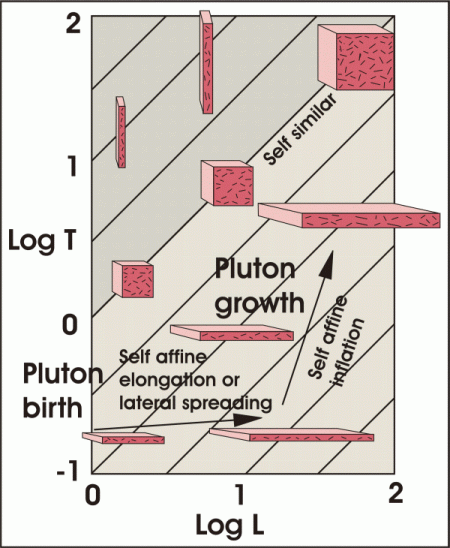
Figure 2. A two-stage growth model for sheet intrusions. Lateral spreading causes self-affine horizontal elongation (a <1), followed by vertical thickening or self-affine inflation (a>1). The net result is a self-affine (slightly less than 1) scaling of sheet intrusions that is reflected in the dimensional data (after McCaffrey and Petford, 1997).
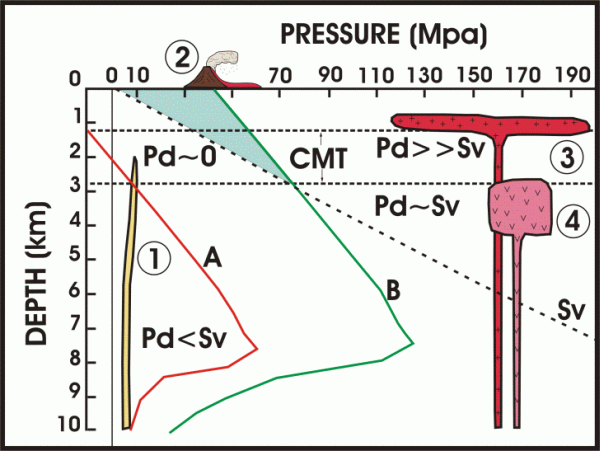
Figure 3. Driving pressure and magma traps. Four hypothetical cases illustrating the role of magma driving pressure (Pd), vertical stress (Sv) and crustal magma traps (CMT). (1) Rising magma has the potential to continue its ascent through the homogenous crust to a depth where Pd becomes negligible. For (Pd)A this depth is approximately 2 km and because Pd < Sv at the emplacement level the magma will crystallise as a dyke, oriented perpendicular to the direction of the least principal stress. (2) In contrast, magma that maintains a large, positive Pd at surface (such as (Pd)B) has the potential to erupt. However, the presence of a subhorizontal anisotropy can act as a CMT, terminating magma ascent at a deeper crustal level, if Pd e Sv (hatched region) at the depth of anisotropy. The final form of the pluton is dependent on the magnitude of Pd relative to Sv at the depth of the CMT. (3) (Pd)B >> Sv and the magma has sufficient Pd to lift the overburden and spread out along the CMT, crystallising as a subhorizontal sheet. (4) (Pd)B H Sv and although the ascending magma will be trapped by the CMT, it has insufficient Pd to lift the cover rocks and crystallises as a steep-sided, relatively flat-topped stock or batholith (after Hogan et al, 1998).
McCaffrey and Petford, (1997) suggested that the specific emplacement model given here for sheet intrusions is strongly coupled to the ascent mechanism, with vertical dyke ascent a prerequisite for horizontal sheet geometries. The final size of the intrusion may simply reflect the depth to the source region, with the deepest source regions providing the greatest amount of magma pressure at the level of emplacement.
In the absence of a specific 'magma trap' there is an
observed switch, in many cases, from vertical dyke emplacement to horizontal
sill emplacement due to a switch in the principal stresses acting around the
intrusion (magmatic intrusion rates of 10-10 - 10-12
s-1 are significantly faster than tectonic strain rates of
10-14 - 10-16 s-1). In the case of a feeder
dyke, emplaced in a tensional setting where s1 is vertical and normal to
s3, the addition of the magma pressure
(Pm) of the intrusion itself to s3 and
the related increase in s2 (in proportion
to the Poisson coefficient, v, of Pm) can lead to the lithostatic component
(s1) being exceeded by both of the lesser
principal stresses. When this occurs the principal stresses effectively
'switch' and s1 becomes horizontal and
s3 change repeatedly, a
cylindrical or saucer-like body may be produced.  Total Breast Health Book
Total Breast Health Book
Total Breast Health: The Power Food Solution for Protection and Wellness REVIEWS: By A.. Offer Price : USD 9.95Shipping Free
Offer Price : USD 9.95Shipping Free
During the emplacement and growth of laccoliths (Kerr and Pollard, 1998), the available magma pressure increases in proportion with the vertical height of the feeder dyke; i.e., the available magma pressure during emplacement depends on the transport distance and hence depth to the source region. The geometrical similarity and observed scaling relationship between laccoliths and plutons can thus be explained if granitic plutons are emplaced in a similar way to laccoliths, with their final aspect ratio a function of available magma pressure during intrusion.
In laccolithic emplacement most models assume a two-stage process involving the formation of an initial sill following by growth. Both stages are driven by the overpressure of magma at the emplacement site. Vertical growth of laccoliths, or in-situ ballooning, takes place by elastic, elastic-plastic or ductile bending of the roof rocks, lifting of a piston by displacement on faults, or a combination of these mechanisms. 'Space creation' here is ultimately accommodated by surface uplift and subsequent erosion. The amount of vertical growth is a function of the horizontal cross sectional area of the laccolith, the strength and effective thickness of the roof rocks, and the available driving pressure of the magma. It would appear that laccolith growth is self-limiting and rarely exceeds 2 km; further growth requires either rapid removal of the roof at the surface by erosion or gravity collapse, simultaneous depression of its floor, or multiple episodes of magma injection (Kerr and Pollard, 1998; Brown and McClelland, 2000; Molyneux and Hutton, 2000; De Saint-Blanquat et al., 2001).
Where laccolith emplacement takes place in an active extension zone (as in Cornubia) the laccolith becomes asymmetric, resembling a wedge shape, with the feeder dyke offset (Roman-Berdiel, 1999) to the 'opposite' side of the body and the long 'hypotenuse' side pointing away from the direction of extension or decollement. If we take the possibility that both Dartmoor and Bodmin Moor are asymmetrical laccoliths (based on gravity data; Bott et al., 1958; Tombs, 1977) that 'face' northwards, then this modelled response to extension reflects the reality of D3 SE facing Post-Variscan extension in Cornubia (Alexander, 1997).
Most studies consider laccoliths to be shallow level intrusive phenomena, with all documented examples occurring at palaeodepths <3 km (Cruden 1998). Data suggests that the aspect ratios (height/width) of laccoliths increase with depth. This is because horizontal sill propagation or growth is favoured over roof lifting with increasing overburden thickness. At greater depths lopoliths form and that there appears to be a continuous transition between the two intrusive styles at around the 3 km depth (emplacement) mark. Lack of evidence for roof-lifting coupled with evidence of downfolding of wall rocks and gravimetric models of granites with inwardly inclined floors suggest that many plutons are geometrically similar to lopoliths. However, the form and wall-rock structure of these lopoliths formed by downward sagging of wall rocks after intrusion of the magma with the inference that space for the tabular body is made by depression of the floor during intrusion. The space created for magma by floor depression must be redistributed at the crustal scale (Brown and McClelland, 2000). Material can either be forced away from the column feeding the pluton (a form of crustal boudinage) or, the more likely mechanism, as material is fed to the pluton from the source region, the pluton founders into the deflating restite zone at depth. This creates a balanced system with the degree of foundering matching the volume of magma transferred up the dyke system to the pluton. Given that this downward deformational transfer of material takes place in hot (high heat flow and advected mantle heat), ductile, lower to middle crust, it is reasonable to assume that the principal mechanism of mass transfer will be by ductile flow. Homogeneous deformation as well as displacements on shear zones, or flexural slip on initially anisotropic planes are likely (Cruden, 1998). Vertical compaction of the partially molten restite source region combined with lateral flow towards the extraction point is also likely. This may result in the development of asymmetric melt-filled structures often observed in migmatite terranes (Weinberg and Searle, 1998).
Cruden (1998) put forward two models to explain the mechanism of floor depression and discussed their relative merits (see Figure 4). In the 'cantilever' model, pluton growth occurs by tilting of the floor about a pivot point located at the perimeter of the pluton, farthest away from the feeder dyke or pipe. The underlying crust deforms by bulk progressive simple shear as it sinks into a regional of partial melt in the lower crust. It is assumed that resistance to slip on the melt-filled conduit is negligible. In the 'piston' model, growth occurs by depression of a horizontal floor, which is accommodated by a vertical, cylindrical shear zone (or ring dyke) at the perimeter of the pluton and displacement along the feeder channel itself. The piston falls into a partially molten source region at depth. Although greatly simplified, aspects of these two models show a reasonable geometric similarity to many tabular granites.
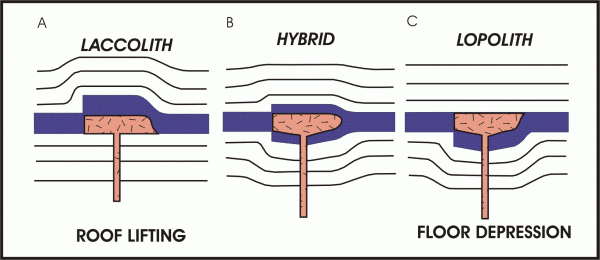
Figure 4. Models of tabular granite emplacement. On the left side of each diagram space is made for the intruded unit (stippled) by offsets along faults; on the right by ductile deformation (after Cruden, 1998).
When these two contrasting methods are mathematically modelled, two interesting results are produced. For the same time, larger plutons require lower strain rates to depress their floors, provided the magma supply rate is sufficient. A consequence of the model geometries is that filling times for the cantilever plutons are half those of pistons, although this does not profoundly influence the resulting strain rates (bulk finite strains are predicted to be low and may not result in distinctive fabrics). It was also found that the piston method was less energy efficient (unless the bounding faults were lubricated by magma, as in a ring dyke) than the cantilever model, making this option the energetically more favourable.
Plutons emplaced by floor-depression mechanisms should show a number of diagnostic features. The cantilever mechanism results in a pluton with a floor that is inclined towards a vertical magma conduit (Grocott et al., 1999) and low bulk strains in the underlying floor rocks. However, progressive rotation of the floor of the pluton and deformation of the underlying rocks may be accommodated by displacements on discrete structures, rather than a homogeneous shear strain. Steepening of a horizontal floor may occur by displacements on high-angle normal faults resulting in a stepped basal contact, or deformation may be focused on low-angle shear zones, sub-parallel to the tilting pluton floor. Structures such as these have been described from layered mafic intrusions and there is no reason not to believe that silicic magmas would not behave broadly in the same manner. Plutons emplaced by the piston mechanism will have flat floors, vertical sides that correspond either to faults, ductile shear zones or feeder dykes, and negligible bulk strains in the underlying crust. A hybrid mechanism (see Figure 5) can also be envisaged in which a component of piston sinking results in steep sides to the pluton and a cantilever component produces an inclined floor (Cruden, 1998).
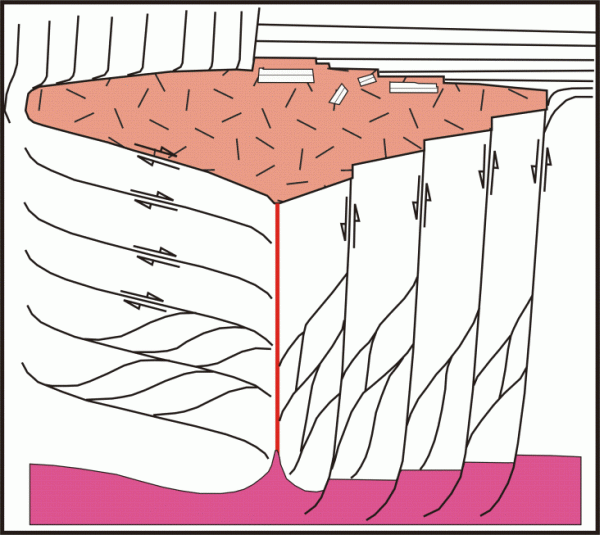
Figure 5. Schematic cross-section of a pluton (stippled) emplaced by a combination of cantilever and piston mechanisms. Shear strain is accommodated by displacements on high-angle normal faults (right side) or low-angle shear zones (left side). With increasing depth, deformation associated with these structures is likely to become more distributed and may also contribute to the upward channelling of magma. Note the heterogeneous thinning of the magma source region (anastomosing pattern) due to decrease in volume withdrawn away from the conduit. Some modification of the pluton roof (with initially horizontal and vertical markers) either by stoping (right half) or ductile deformation during initial lateral spreading (left half) is also likely. (after Cruden, 1998).
In a real geological environment these processes are unlikely to act in complete isolation, in some ways this will accelerate the above processes in that downward transfer of material can be accommodated by displacements on a large number of active, and in some cases melt-lubricated, faults and shear zones (Holdsworth et al., 1999). It is also more likely that larger plutons will be fed by a series of dykes and that rather than be continuous; the supply of magma may be episodic, resulting in a series of magma pulses to reach the pluton (Weinberg et al., 2001). In this way complex magma mixing and differentiation may develop (Menendez and Ortega, 1999) as well as complex internal intrusive contacts between magmas in varying states of crystallisation (Fernandez and Castro, 1999a; El Desouky et al., 1996). The dyke transport mechanism will allow these features to develop as large tabular granites can be emplaced over geologically rapid times (<100 a to 1 Ma) without requiring unreasonably fast deformation rates in the underlying crust.
Many current models for granite emplacement stress the importance of active faults (Paterson and Schmidt, 1999; Yoshinobu et al., 1998) or shear zones in focusing magmas into transient dilational jogs (Hutton 1992). The link between tectonism and plutonism in these models means that rates of tectonic processes will be a major controlling factor in pluton emplacement. Plutons emplaced within active shear zones generally show tabular sheeting (Brown and McClelland, 2000) on a metre scale as their emplacement i.e., steep sheets in transcurrent fault zones, is tied to fault increments and their orientation controlled by fault geometry (McCaffrey 1992). Most high-level plutons are not emplaced entirely within fault zones, however, and it is visualised that tabular sheets have upper and lower contacts defined by pre-existing structures in the wall rocks such as shear zones, formational boundaries, bedding and cleavage. Seismic reflection surveys show many plutons have floors which dip at 0° to 40° which steepen towards one or more root zone magma conduits (Cruden, 1998; Vigneresse, 1990; Ameglio and Vigneresse, 1999; Hecht and Vigneresse, 1999). This root zone is commonly associated with a pre- or syn-emplacement shear zone, which may have acted as a pathway for magma ascent, though there is often little evidence that the emplacement of the bulk of the magma is itself related to the structure.
The emplacement of magma into active shear zones initially takes place along a plane normal to the least principal stress (Fernandez and Castro, 1999b; Castro and Fernandez, 1998; Vigneresse et al., 1999) and in the form of a steep-sided wedge-shaped structure with deep root zones. If the shear zone (pull-apart system) continues to dilate, further pulses of magma will be drawn in and a zoned, cylindrical body will result (appearing diapir-like) with imposed structures in the country rocks mirroring the contact (Castro and Fernandez, 1998; Correa-Gomes et al., 2001). The intrusive structures produced in this way have a great deal of similarity with those seen in some of the Cornubian granites, such as Carnmenellis (see Figure 6).
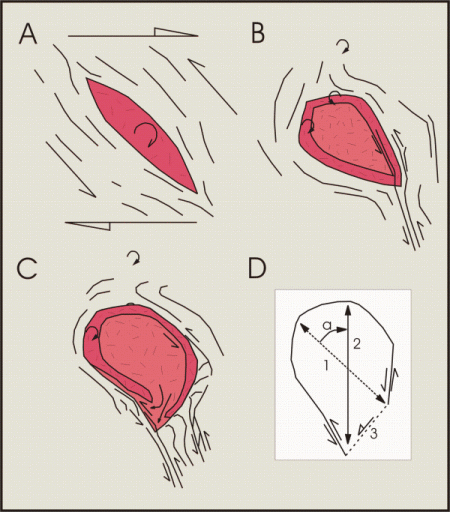
Figure 6. The evolution of the Plasenzuela pluton, Spain. (a) The opening of the walls of the magma-filled fracture, normal to the least principal stress. (b) and (c) rotation of the pluton with fresh magma emplaced in the centre; foliations and folds in the country rocks are also rotated. (d) shows the original orientation of the long axis of the pluton (1) and the present long axis (2), a marks the rotation sense and (3) is a shear zone that aided the growth of the pluton (after Castro and Fernandez, 1998).
Space may also be made for an intrusion by the translation of sections of the wallrocks. In ductile environments this is accompanied by rotation and pure strain (shape change) and may result in the 'pushing aside' of the country rocks by several km (Tikoff et al., 1999). Such 'forceful' emplacement is envisaged as taking place with an incoming magma (as a crystal mush) acting on a rheologically strong unit, which in turn has a 'knock on' effect on surrounding tectonically weaker units. This type of behaviour has been modelled (Roman-Berdiel, 1999) in 3D in the laboratory and contrasts sharply with static emplacement in brittle conditions (Roberts, 1970) which results in cylindrical piercing intrusions (reminiscent of the outcrop pattern of some of the Cornubian plutons) and stoping.
Along with physical methods of emplacement, magma and host-rock chemistry can also play an important part in space creation. Yoshinobu and Girty (1999) found that elemental transfer (particularly Si) out of the country rocks and into the magma, lead to mass transfers of up to 12 vol% during contact metamorphism. Such volume losses in the country rocks conversely create space for the pluton as long as it remains above the solidus.
Modern analytical techniques including 3D inversion of seismic data and anisotropy of magnetic susceptibility (AMS) are being used to deduce the 3D shape of granitic plutons and their infilling history. AMS is used to detect the orientation (dip, plunge, etc) of magmatic flow fabrics in plutons and has been successful in detecting the feeder zones of some plutons as well as being used to deduce the relationship between the magmatic and host-rock fabrics (Mintsa Mi Nguema et al., 2002; De Saint-Blanquat et al., 2001). Seismic modelling techniques (Cruden et al., 1999; De Saint-Blanquat et al., 2001; Vigneresse, 1990; Ameglio and Vigneresse, 1999; Hecht and Vigneresse, 1999; Vigneresse et al., 1999) have helped elucidate the shape of the underside of granite plutons (which approximate to both horizontally and vertically disposed tabular bodies; Vigneresse et al., 1999 ), something not previously deduced by other techniques. The data shows that many of these bodies have a flat or tilted base, marked by funnel-like depressions that connect with feeder dykes (Vigneresse et al., 1999); these funnel depressions are likely to have formed in response to reciprocal floor collapse as melt is drawn off from the source region (Cruden, 1998). Many bodies have more than one cylindrical feeder dyke, or may be fed by one linear dyke running along the long axis of the intrusion (De Saint-Blanquat et al., 2001). Further development and use of these techniques, together with a better understanding of the rates of magmatic and tectonic processes throughout the granite cycle will give us a much greater understanding of the processes that lead to granite emplacement.
The movement of magma, via dyke transport, allows for rapid transport from source to emplacement site and allows sizable intrusions to form without the loss of the feeder dykes to crystallisation (providing they are above the critical width).
The emplacement site is largely determined by the magma driving pressure, the lithostatic load and the nature (inhomogeneous or not) of the crust through which the magma is passing. Magma will find its own level in response to crustal traps and confining stress, or will passively fill open-space sites within pull-apart systems; it will also, in other cases, modify the local stress field to form laccolithic intrusions (Vigneresse et al., 1999). Not all intrusions show evidence of passive emplacement; some may show forceful characteristics, such as in-situ ballooning, horizontal movement leading to the translation of geological markers, sometimes over many kilometres (Tikoff et al., 1999).
The tabular nature of many plutons, the tendency to form sheet-like bodies in horizontal and vertical planes and their apparent scale-invariance is being identified in many major batholiths, as they are re-appraised (Petford et al., 2000). The known, gravity modelled, tabular form of the Cornubian Batholith (Tombs, 1977), its composite nature (Salmon, 1994; Chen et al., 1993) and the laccolithic nature of some of its cupolas (Edmonds et al., 1975), together with structural data from the granites (this study) and cover rocks (this study; Alexander, 1997) strongly suggest that we view the Cornish granites in terms of this new model of magmatic genesis, transport and emplacement and move away from the old model of the diapiric batholith.
![]()
This page last updated 28/02/2013